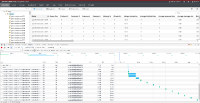Details
-
Bug
-
Resolution: Done
-
Minor
-
jboss-fuse-6.2
-
None
-
%
-
6.3 Sprint 4 (Mar 28 - Apr 29)
Description
This is the engineering counterpart of JBFPL-244, which was accepted after review.
When the Hawtio console is used to monitor ActiveMQ operation, in situations where there are thousands of queues, with many consumers each, the whole of the Hawtio user interface behaves very badly. At best, it will be very slow. In other situations there will be "slow script" warnings from the browser, or just internal timeouts that lead to the displayed data being incomplete.
In Fuse 6.1 the problem was better defined, because the Jolokia "maximum collection size" setting was fixed at 500. This was nowhere near large enough to handle the thousand-queue situation, so many queues were simply omitted from the display. This was unsatisfactory, but at least the rest of the Hawtio interface worked properly. In 6.1 R2 P6 the maximum collection size was increased to a huge value (see ENTESB-1641), with the result that the display was correct in situations where there were perhaps a couple of hundred queues, with a couple of consumers each. In situations with thousands of queues and many consumers per queue, this large collection size is a liability, because the huge amount of data involved will lead to script warnings, time-outs, and generally a slow user experience.
In Fuse 6.2 the Jolokia maximum collection size is configurable, but that still leaves customers with an uncomfortable choice between truncating their data, or having a slow, buggy experience.
While it's clear that displaying a larger amount of JMS-related data requires a larger amount of network traffic and more intensive script operation, we don't experience the same problem using JConsole to monitor A-MQ. So the problem should not be impossible to solve, even though it might require a significant re-working of the Hawtio-Jolokia-ActiveMQ interaction.
This problem can be reproduced using a simple Java program that creates thousands of queues with, say, ten consumers each. The degree of badness of the problem will depend on the browser used, and how fast the browser workstation is.
I'm told that this isn't actually a bug. It seems that we cann't handle thousands of queues without passing a huge amount of data, which would necessarily be slow. However, I think we could, in principle, rethink the way the interface worked, so that such large data volumes weren't needed.
Attachments
Issue Links
- is duplicated by
-
ENTMQ-1787 Keep consuming browser's memory just by clicking tab menu on hawtio management console
-
- Closed
-
- is related to
-
ENTESB-6357 Hawtio v2 OpenShift RBAC plugin
-
- Closed
-
-
ENTESB-4996 Viewer role able to create/delete queues and messages via Hawtio
-
- Closed
-
-
KARAF-4351 Loading...
- relates to
-
ENTESB-3228 High CPU usage when using hawtio
-
- Closed
-
-
ENTESB-1884 Hawtio becomes unavailable when there are more than 500 destinations created and also during the time when they are created.
-
- Closed
-
-
ENTESB-2453 Dashboard - adding and removing widgets causes gradually increasing browser's CPU consumption
-
- Closed
-
-
ENTESB-5204 Gradually increasing memory consumption of Hawtio overtime
-
- Closed
-
